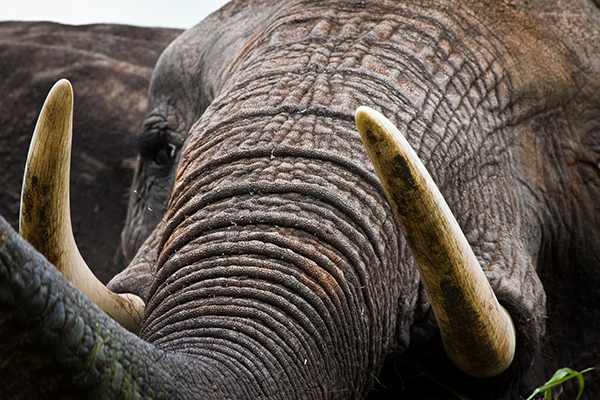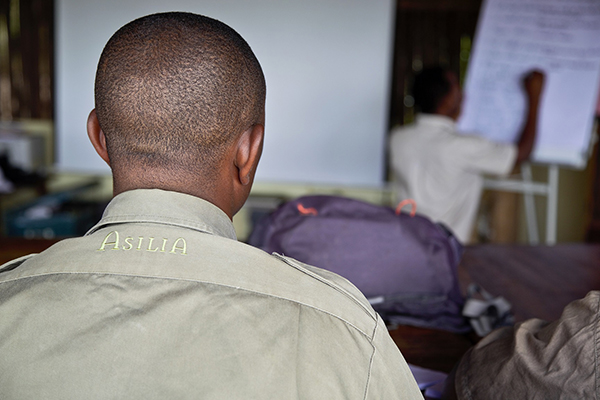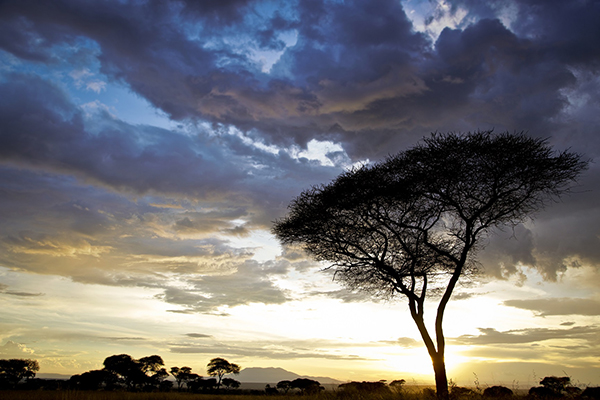The road to becoming an Asilia Guide: Crunch Time
By Stuart Butler
It was all coming down to this. For more than a month I have been sitting in on an Asilia Africa wildlife guide training camp in Tanzania’s Tarangire National Park. I’d learnt how to track elephants and big cats, I’d found out how to tell the difference between a shrike and a go-away bird, I’d discovered unlikely facts about a buffalos digestive system and, perhaps most importantly, I’d learnt how to mix the perfect gin and tonic. But now, on my final day in Tanzania, it was time to put it all to the test. Asilia Africa’s top two wildlife guides, Pietro Lurashchi and Lorenzo Rossi, had prepared an exam for all the participating guides and they asked me to take the mammal exam.
The last time I had sat an exam was at the end of my A-Level biology course in the UK more years ago than I really care to remember. I still recall opening up the exam paper, scanning through the first couple of questions, sighing and merely closing the paper again. I spent the rest of the exam carefully studying my finger nails. Needless to say I failed my A-Level biology in quite spectacular form. This time though was going to be different. For a start there hadn’t been the distraction of a beach in the nearby vicinity where I could spend my revision time going surfing.
Lorenzo handed out the exam papers to the dozen or so guides and set the ground rules. No looking at books. No talking. No slyly checking on the internet. No cheating. This was disappointing because I’d been planning on engaging in at least one of these activities. The clock started ticking. We had two and half hours.
First question. Name. Okay that one I could do. If the other questions continued in this manner then I could have the exam polished off in an hour and then go and see how the bar training and cocktail mixing course was going.
The first half of the exam had questions that related to what a guides job actually entailed and were pretty straight forward. What is a guide? A guide is someone whose job is to enhance a guests experience of the African bush, to add an extra dimension to their stay, to answer their questions as best they can, to increase the knowledge of their guests in a discreet manner, to point out the wildlife and plants and interesting facts about them and to drink gin and tonic.
Things got trickier by question four which invited us to define guest empathy. I actually had no idea what the word empathy meant so I left this one. Never mind we only had to get sixty percent of the questions correct in order to pass so I could afford to mess one or two up.
Next we were asked to list actions that could be considered as ‘serious misconduct’. Seeing as how I am a natural angel whose never done wrong I found this one hard, but I hazarded a couple of guesses such as: Running guest over with safari vehicle (though this is okay if vehicle belongs to a different safari company) and Encouraging guest to try and stroke a lion.
The next set of questions revolved around how a guide should interact with a guest and included questions such as: Name 3 types of communication? Again this was simple and I put Email, telephone and Facebook. I thought the next question which asked us to list the general rules to follow when using the radio a bit of a strange one but nevertheless I was still able to provide an answer: 1 Make sure you pick a radio station playing the kind of music the guest might like. 2 Dance appropriately – no dirty dancing.
Frankly, this was a breeze and I began to fancy that I might soon be replacing Pietro as Asilia’s head guide. But then we moved onto mammal related questions and things started going downhill quite fast. Now, in my defence I think that was partially because Lorenzo and Pietro, who are both Italian, must have conjured up some of these questions late one night when they were both tiered and had forgotten how to write in English. I mean how else do you explain a question like this? What does Myrmecophagia and osteophagia mean? Because I didn’t understand these sort of long, ridiculous and clearly made up words I refused to answer these questions.
To make matters worse they then threw in a couple of trick questions such as What are the four orders in which the artiodactyla has been divided? Being a bit of a cultured sort I knew straight away that artiodactyla was clearly a kind of pasta made by Lorenzo’s grandmother, but really sliding this into an exam on mammals was a bit unfair on those not as cultured as me.
And then suddenly I was on the last question. Briefly describe the ruminates digestive system? To which I was able to confidently write that: A ruminant chews some grass which gets mashed up in its stomach and then comes back up to its mouth for another good old munching before going down into a second stomach for a bit more digesting. This is a brilliant system if you just ate something nice like, say, ice-cream, but it’s a crap system if you just ate something not so nice like, say, brussel sprouts.
I’ve now left the guide training course in Tarangire and am eagerly awaiting my exam results. It’s of course already a foregone conclusion that I’ve passed but the big question is by how much? In my next blog post I will let you know the results. Talking of future blog posts. With the guide training now over my blogs for Asilia will be changing somewhat (they might even occasionally verge on being serious) and over the next few weeks I will be writing about everything else I experienced over this past month: The meetings with a Maasai loiban with a rumoured forty wives and three hundred children; the week I spent following the wildebeest migration through the Serengeti; the interviews I conducted with ex-hunters and poachers; the Asilia supported community projects I visited and the days I spent trailing around after elephants and lions are just some of the many stories left to tell.
Follow Stuart Butler’s road to becoming an Asilia Guide
Part 7 – Crunch Time
The post The road to becoming an Asilia Guide: Crunch Time appeared first on Asilia Africa.










